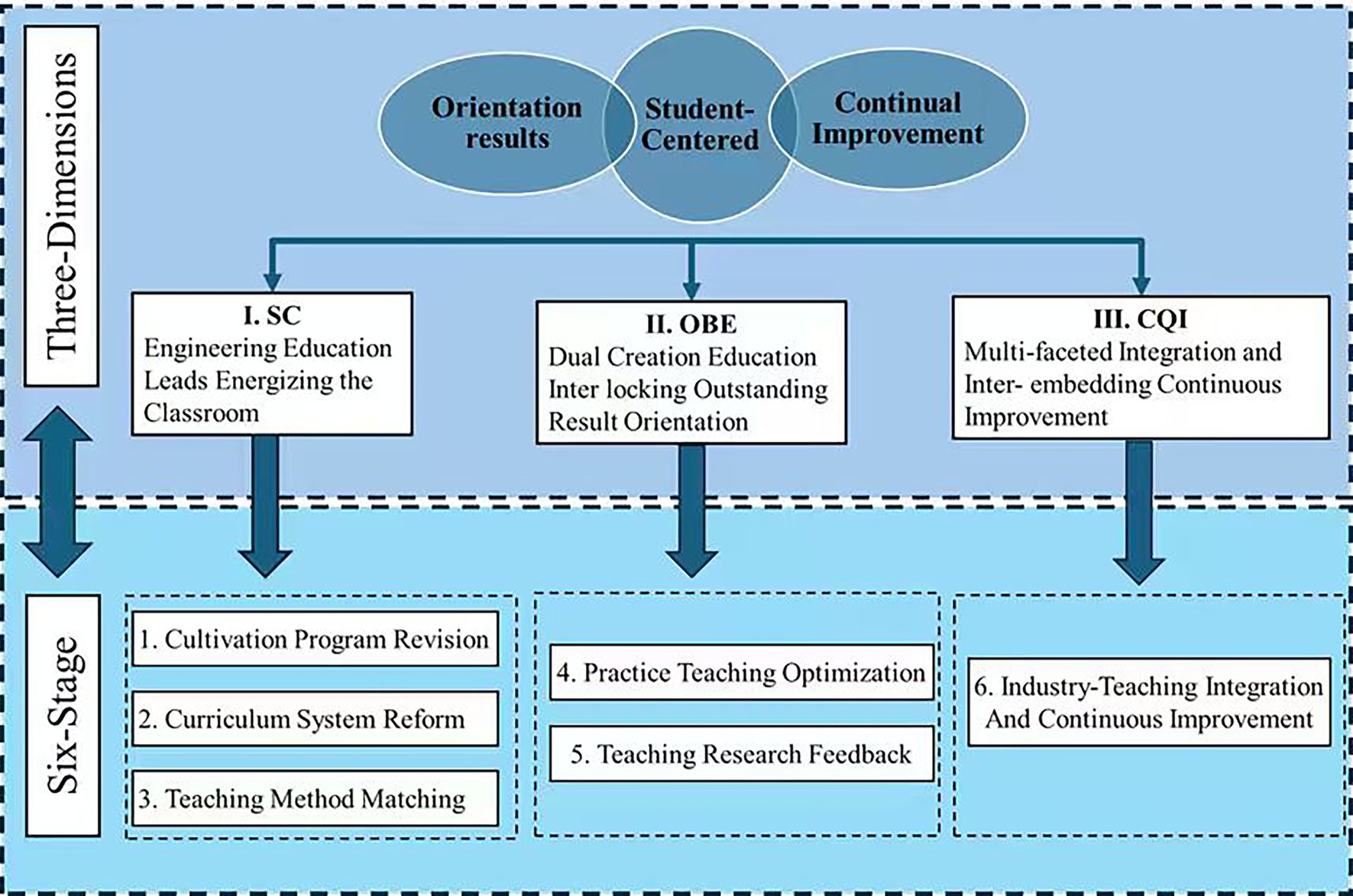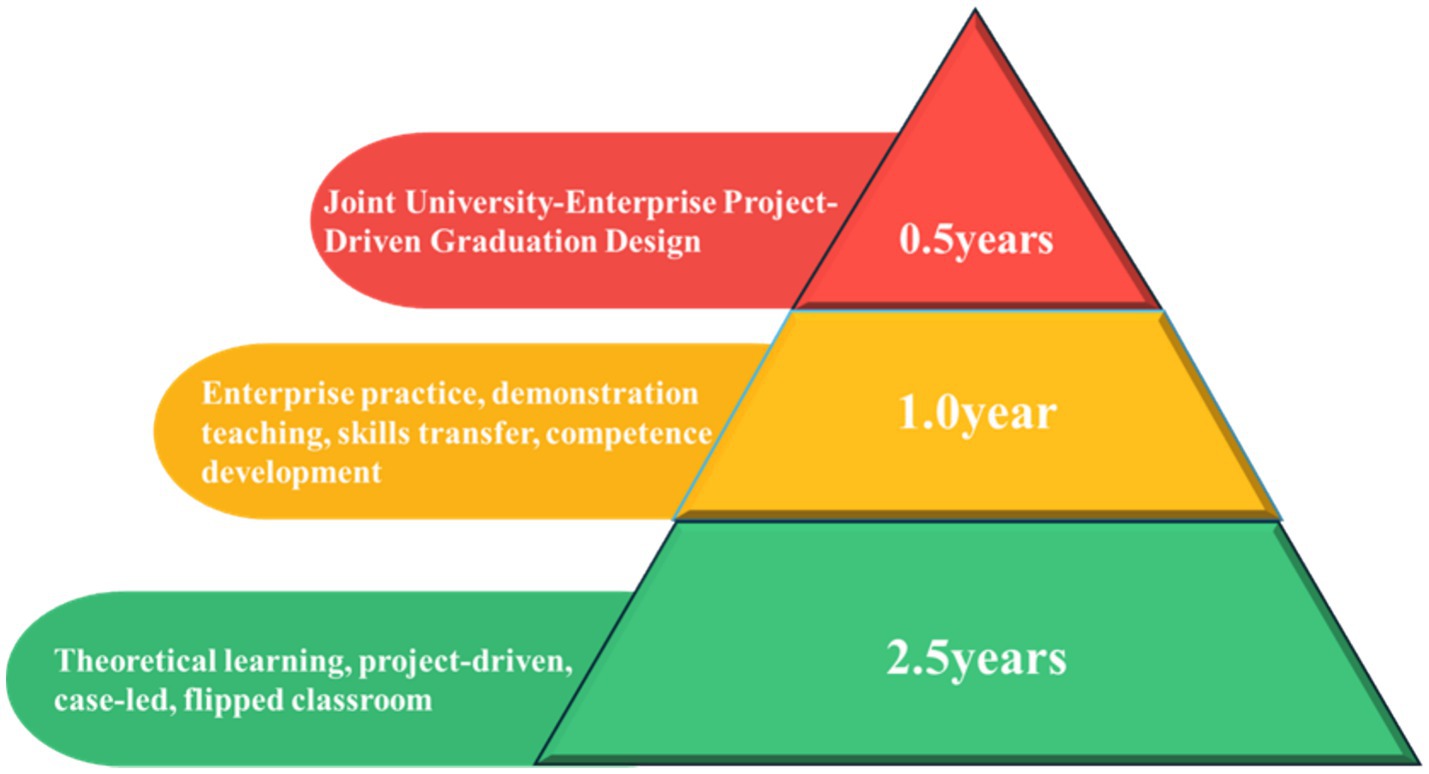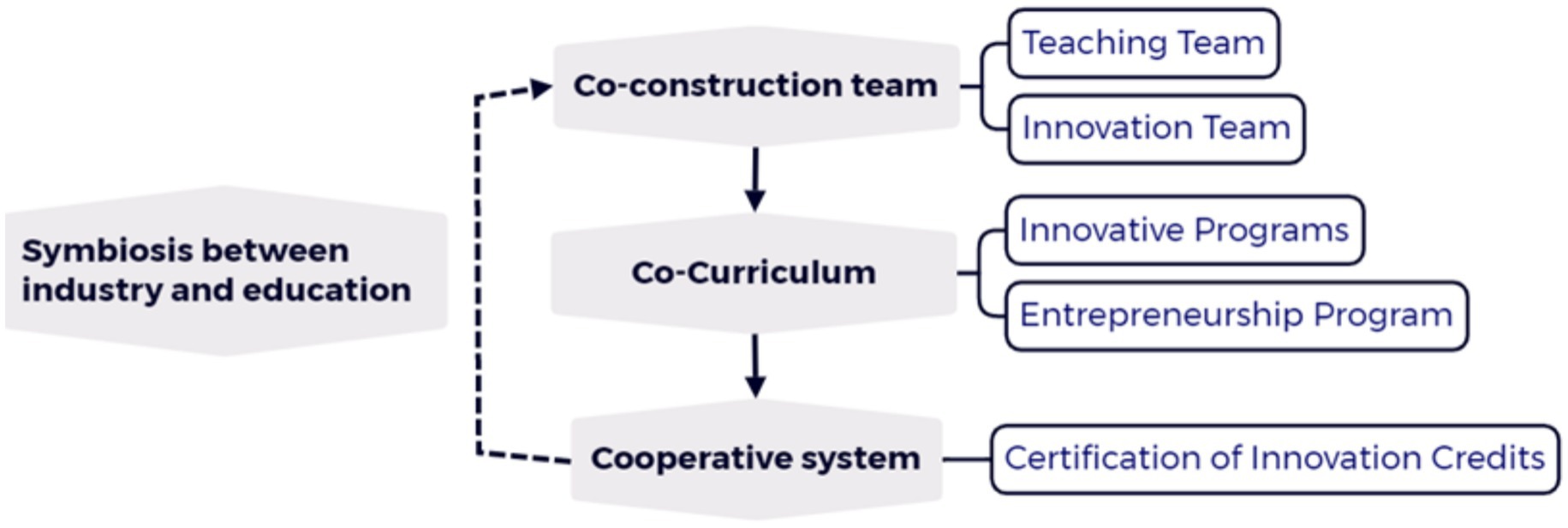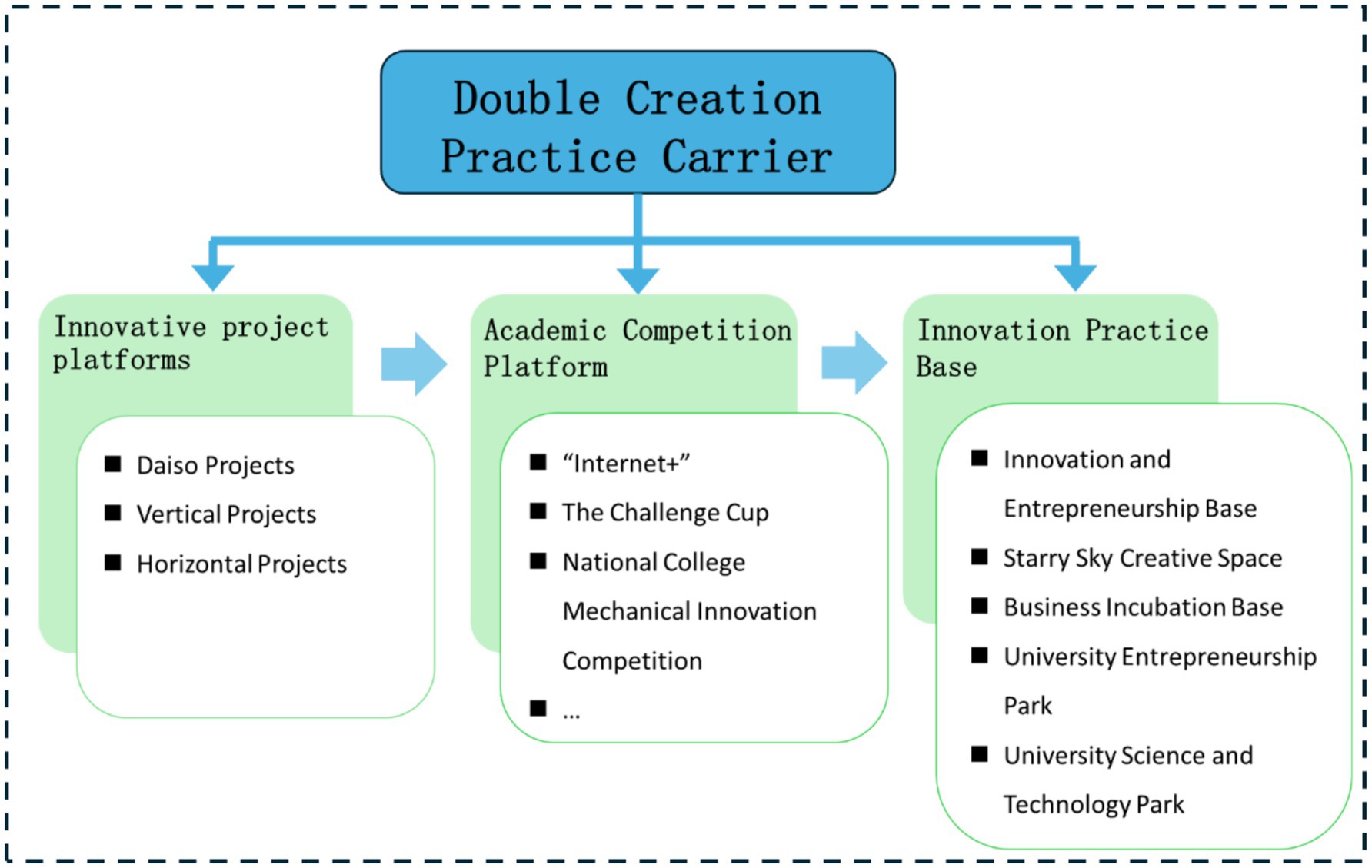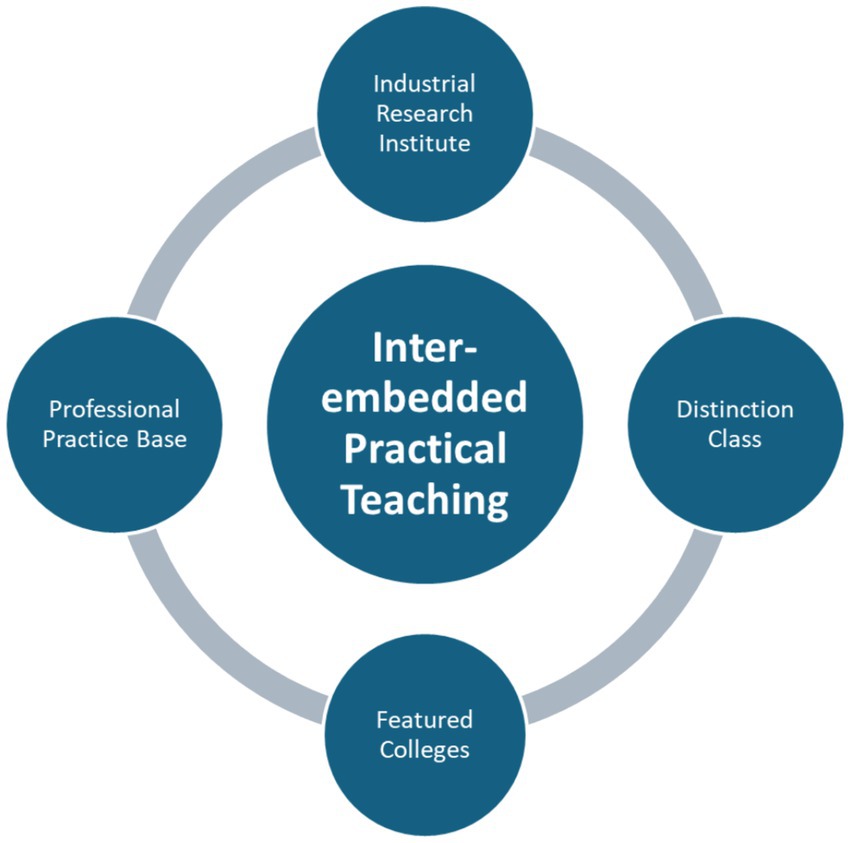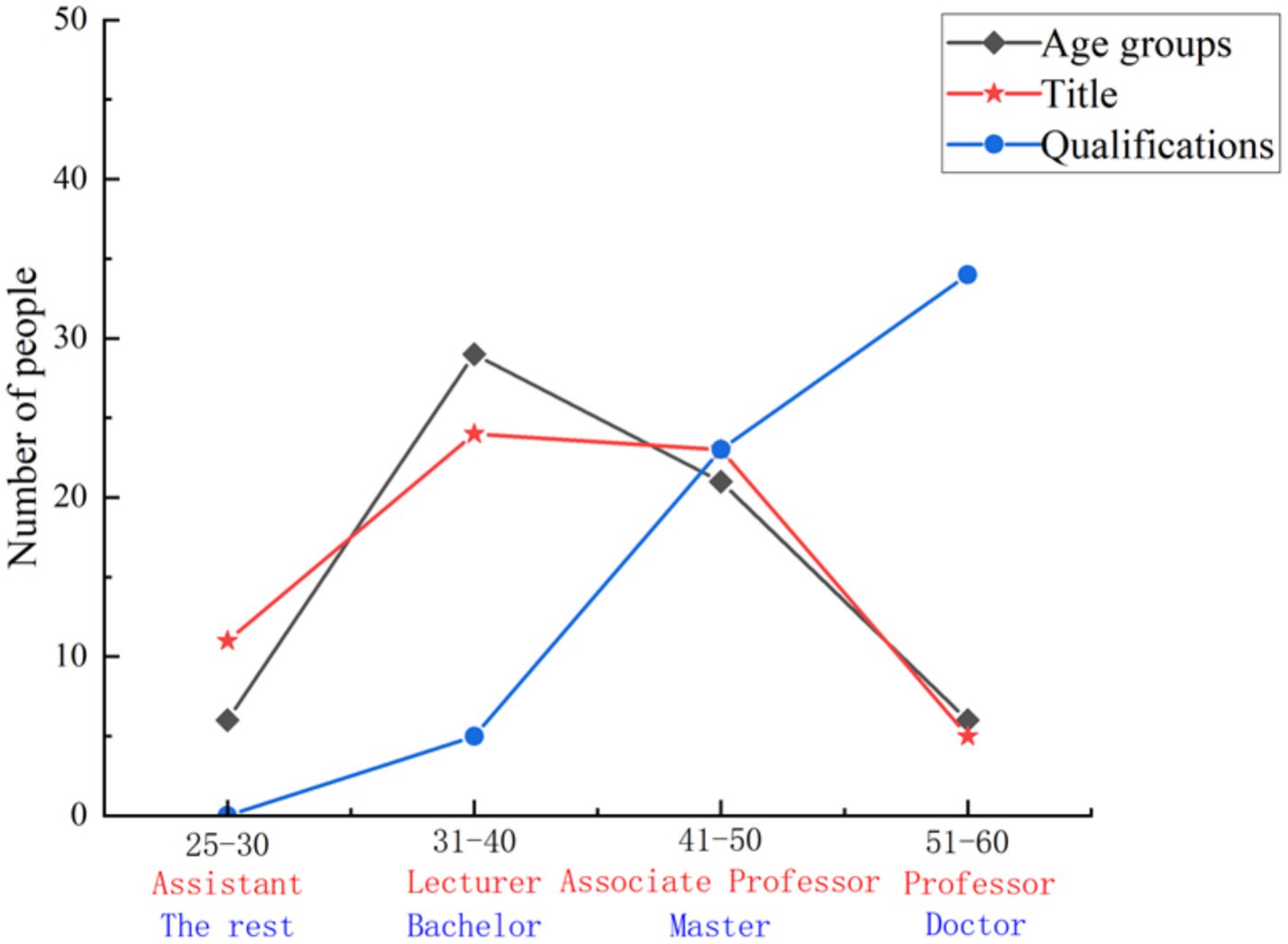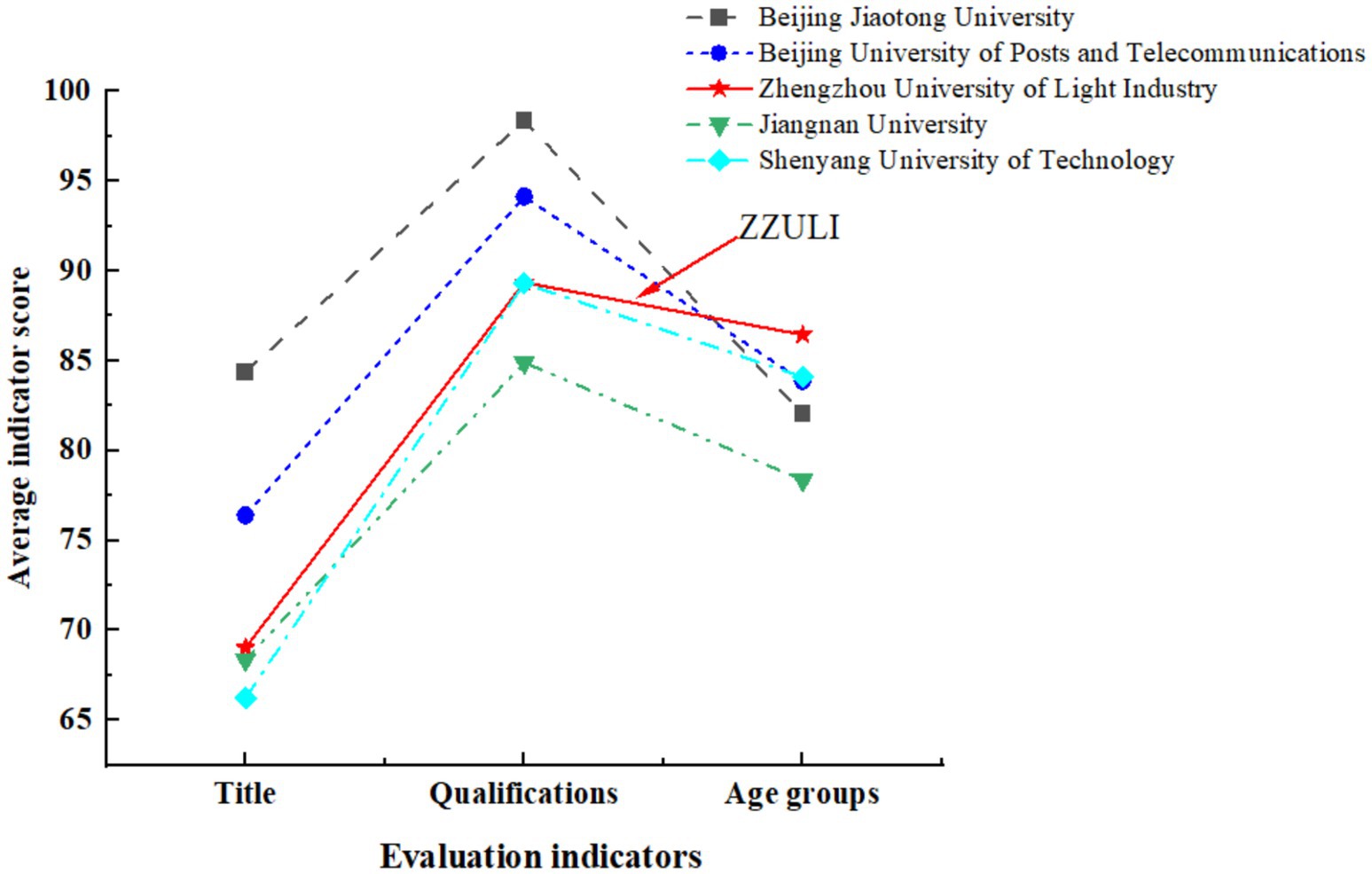- 1College of Electrical and Mechanical Engineering, Zhengzhou University of Light Industry, Zhengzhou, China
- 2College of Economics and Management, Zhengzhou University of Light Industry, Zhengzhou, China
To implement the concept of “Student-Centered, Outcome-Based Education, and Continuous Quality Improvement” engineering education, exploring the establishment and implementation of an inter-embedded mechanism between innovation and entrepreneurship education (dual-creation) and engineering education. This study is based on the teaching reform practices of Zhengzhou University of Light Industry. It proposes a “three dimensions-six stages” inter-embedded cultivation mechanism using case studies, questionnaires, and comparative analysis. The mechanism is built on six phases: Cultivation Program Revision, Curriculum System Reform, Teaching Method Matching, Practice Teaching Optimization, Teaching Research Feedback, and Industry-Teaching Integration with Continuous Improvement. A quality evaluation function for the teaching team has been established. After research and data analysis, the results show that the distribution of professional titles among our school’s innovative teacher team follows a normal distribution from junior to senior levels. The comprehensive quality evaluation score is 82.68, which is in the good category. It consists of the university’s emphasis on innovation and entrepreneurship education. Student feedback indicates a lack of proficiency in solving complex engineering problems. It necessitates continuous improvement and optimization of the inter-embedded teaching system.
1 Introduction
The primary objective of training outstanding engineering talent is to cultivate a di-verse group of high-quality professionals with strong innovation capabilities, who are well-aligned with the evolving needs of economic and social development and are equipped to face the current state of the industry, the global landscape, and future challenges. Since the launch of China’s national “Excellent Engineer Education Training Pro-gram” initiative in 2010, a total of 194 universities have been recognized as implementing institutions in that program. Additionally, 559 undergraduate and graduate students have participated in the initiative (Ministry of Education of the People's Republic of China, 2010, 2011, 2013). In June 2013, China became a signatory member of the Washington Accord, incorporating the educational philosophy of “Student-Centered (SC), Outcome-Based Education (OBE), and Continuous Quality Improvement (CQI)” into the entire process of engineering education. This development has provided an opportunity for the cultivation of outstanding engineering talents who meet the current needs of economic and social development (Wang et al., 2022). Subsequently, in 2017, the “trilogy” for the development of new engineering disciplines was established, encompassing the Fudan Consensus, Tianda Action, and Beijing Guidelines. This also marked the launch of the “Excellence in Engineer Cultivation Pro-gram 2.0,” along with the issuance of the “Beijing Declaration on Excellence in Engineer Cultivation” (Zhu, 2024). These initiatives focus on improving educational quality, promoting international recognition, strengthening school-enterprise cooperation, and comprehensively improving the high-quality training of engineering education. They are of great significance in guiding and demonstrating China’s transition from an engineering education powerhouse to an engineering education superpower.
Dual-creation education is an Innovation and Entrepreneurship Education. It serves as a key indicator for assessing the quality of engineering talent development in universities. The core concept of dual-creation education is to foster the all-round development of students through hands-on innovation and entrepreneurship activities, aiming to cultivate well-rounded and strongly competitive talents. Shanghai Jiao Tong University (Tong et al., 2021) has conducted a series of explorations and implemented a series of practices for integrating and restructuring its entrepreneurship institutes and innovation practice education platforms. The university has thereby incorporated the principles of dual-creation education throughout its entire talent development process, establishing a comprehensive dual-creation education system. Similarly, Anqing Normal University (Cao et al., 2024) has developed a well-structured, “step-by-step” dual-creation practice teaching system, spanning from the freshman to senior year. The university has continuously enhanced its comprehensive practice platform and evaluation mechanisms within the teaching process, thereby effectively improving the professional competence and dual-creation capabilities of its students. Hu Aihua College of Chemistry (Chen et al., 2022) has also deepened its reform model and its mechanisms for organically integrating dual-creation education with engineering education. This integration encompasses policy guidelines, faculty development, cultivation models, practice platforms, industry-academia collaboration, credit substitution, assessment, and incentive systems. Hunan Institute of Technology (Wang et al., 2024) uses classroom teaching, practical training, competitions, and social practice for dual-creation education. This approach creates a multi-level, three-dimensional dual-creation education model.
In recent years, both engineering education and dual-creation education have continuously provided scientific, innovative, and systematic strategies and methods for teaching reform in China’s institutions of higher education. But engineering education lacks systematic discussion and practice in terms of training programs, curriculum system construction, and matching of teaching methodology (Jiang Z., 2024). This paper examines the implementation of Zhengzhou University of Light Industry’s interconnected engineering talent cultivation model, including measures for continuous improvement and questionnaire survey analysis. This paper then presents the construction of a “three dimensions-six stages” implementation pathway for excellence in engineering talent cultivation, aiming to provide both theoretical and practical reference for the development of outstanding engineering talent.
2 Research ideas and methodology
2.1 Research ideas
The general standards for engineering education specify requirements across seven dimensions: “Students,” “Educational Objectives,” “Graduation Requirements,” “Continuous Quality Improvement,” “Curriculum System,” “Faculty,” and “Supporting Conditions.” Based on the institution’s actual circumstances, the three dimensions of “Student-Centered (SC), Outcome-Based Education (OBE), and Continuous Quality Improvement (CQI)” are together adopted as the primary methodology for implementing engineering education. The concept of dual-creation education is embedded into the six phases of the engineering education implementation plan: Cultivation Program Revision, Curriculum System Reform, Teaching Method Matching, Practice Teaching Optimization, Teaching Research Feedback, and Industry-Teaching Integration and Continuous Improvement. This study proposes a “three dimensions-six stages” cultivation mechanism. This approach is designed to achieve the educational objectives of cultivating highly skilled engineering talents. The specific ideas of this study are as follows:
Firstly, it need to optimize the talent cultivation program, change the curriculum system, and innovate teaching methods. The entire process should be SC, driven by engineering education, and embedded with dual-creation education.
Secondly, establish an inter-embedded teaching model, with the OBE of cultivating excellent engineering talents. On the premise of enabling students to master basic knowledge, we should pay more attention to practice, thereby fostering their engineering consciousness and technical abilities.
Thirdly, feedback on the teaching model was gathered through analysis of questionnaire data. We conducted a survey of over 60 innovation and entrepreneurship teachers and 600 students at Zhengzhou University of Light Industry. We also conducted a survey of 73 innovative teachers from Beijing Jiao tong University, 49 from Jiangnan University, and 164 from Shenyang University of Technology. These includes information on the teaching team structure, teacher feedback, and student evaluations.
The ultimate goal is CQI, establish a rapid response mechanism with a dedicated team to monitor technological advancements and industry trends. Enable timely updates to teaching content and methods based on real-time insights. It is continuous improvement of the inter-embedded teaching model, deepening the diversified integration of industry and education (Figure 1).
2.2 Research methodology
Four research methods were used in this study:
Literature Research Method: The team reviewed the literature of engineering education and dual-creation education, searching for theoretical support.
Case Study Method: This study analyzes the case of engineering education and dual-creation education at Zhengzhou University of Light Industry, “three dimensions-six stages” inter-embedded education model was extracted.
Comparative Research Method: This study used comparative method to analyze the differences and similarities between the old and new training programs, with a focus on optimizing the curriculum system and reforming the teaching model. Based on these findings, successful experiences are summarized for practical application.
Questionnaire Research Method: Our goal was to assess the effectiveness of the inter-embedded teaching model. The structural characteristics of the teaching team, feedback from teaching research, and student evaluations were all analyzed. Based on the results, we offer suggestions for continuous improvement. We also recommend deepening the integration of industry and education.
3 Measures taken and their effectiveness
3.1 Engineering education leads and energizes the classroom
3.1.1 Optimization of training programs to meet social needs
According to the needs of social development, the school optimizes the training program and formulates clear graduation requirements. This process aims to strengthen the adaptability, support, and alignment of the educational program (Yang et al., 2021). The optimization and refinement of the training program are exemplified by a comparative analysis of 2019 and 2021 Training Programs. The focus is on the Mechanical Design, Manufacturing, and Automation program of Zhengzhou University of Light Industry. The improvements were made during the period since its engineering education certification.
The university’s 2021 training program builds upon the objectives of adapting to the needs of economic and social development. The program addition aims to produce high-quality applied talents. These talents are characterized by a spirit of innovation. They have practical abilities and are well-rounded in ethics, intellect, physical fitness, and esthetics. The new program is designed to meet societal demands. It focuses on cultivating new, high-quality, productive, and innovative talents. It also aligns with China’s national need for strong educational, scientific, technological, and talent power.
Analysis of changes in the overall distribution of course platforms between the old and new training programs (see Table 1) reveals that the university has increased the proportion of humanities and social sciences courses in the total credit count while reducing the proportion of basic academic discipline courses. The public foundation courses have been adjusted from 31 credits to 32 credits, with an increase of 16 credit hours, demonstrating the university’s commitment to strengthening basic education and providing a strong academic base for the cultivation of innovative talents. From Table 1, one can also see that, although the total credits for innovation and entrepreneurship practice courses remain unchanged, the four-credit elective for innovation practice has been adjusted to a two-credit mandatory course plus a two-credit elective. This adjustment demonstrates how the university has effectively embedded the concept of dual-creation education into its engineering talent cultivation program by optimizing the course structure, highlighting the significant emphasis placed on innovation and entrepreneurship education.
3.1.2 Reform of the curriculum system based on engineering education
The cultivation of innovative and outstanding engineering talents hinges upon the integration of new engineering disciplines with the development of innovative capabilities. It is essential to establish a scientific curriculum system with distinctive features that aligns with the need for applied talent. To meet the engineering certification standards and to place a clear emphasis on the development of the three key competencies: engineering practice ability, innovation and entrepreneurship ability, and lifelong learning ability. Tang et al. (2019), Zhengzhou University of Light Industry has closely aligned its curriculum with modern advancements in engineering and technology. They have developed a curriculum system that better aligns with their training program and graduate attributes. Taking the curriculum matrix for Electrical Engineering and Automation as an example (see Table 2), it is evident that University Physics and Higher Mathematics are included in the general courses related. In addition, basic courses in disciplines such as Fundamentals of Electric Circuits and Electronic Simulation Techniques strengthen students’ professional abilities, enabling them to innovatively research, design, develop, and evaluate complex engineering problems. Embedded Design and Practice of Electronic Technology, Electronics Internship, Production Internship, and other centralized practice teaching courses and innovation and entrepreneurship practice courses are professional practice courses in design/development solutions, engineering and society, and other graduation achievement level index points. They emphasize the cultivation of the ability to analyze complex engineering problems. We have also constructed special course resources such as China University Student Catechism Courses, National Excellence Online Open Courses, and National First-class Undergraduate Courses, which have enriched the inter-embedded course system oriented toward fostering engineering competence.
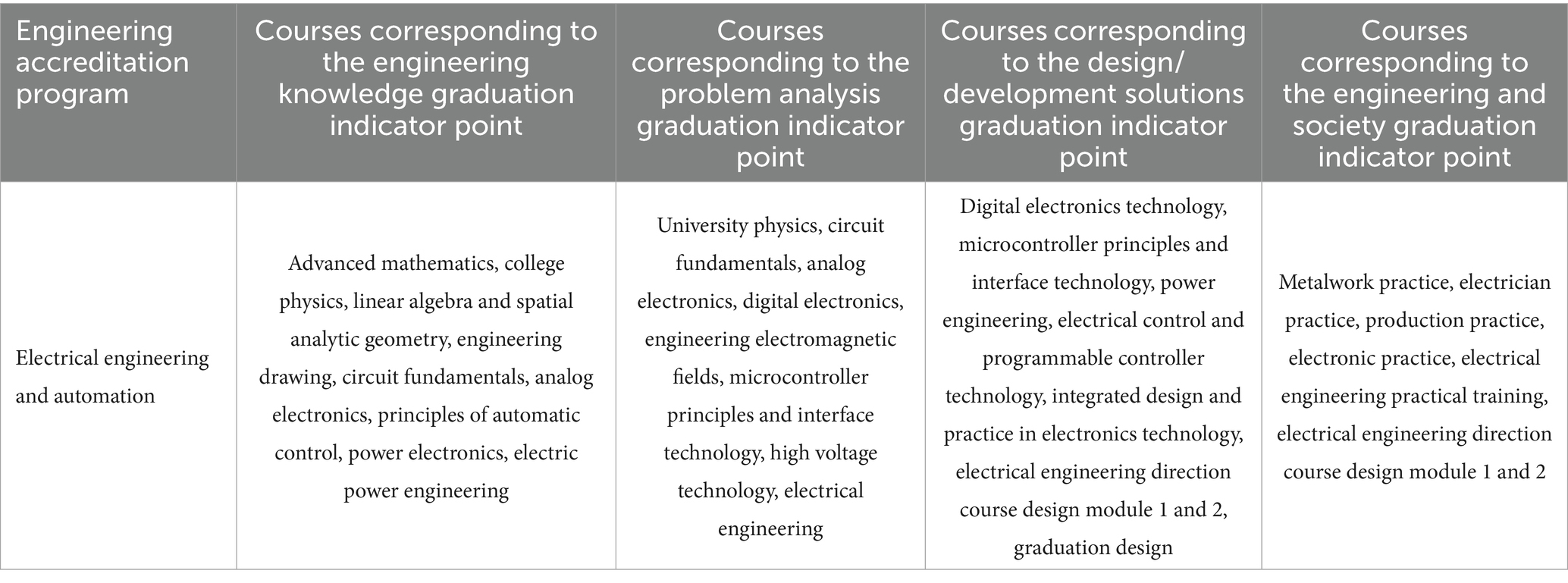
Table 2. Excerpts from the matrix of courses required for graduation in electrical engineering and automation.
3.1.3 Deepening the integration of industry and education and innovating the teaching mode
A new model of industry-education integration for engineering education and dual-creation education has been built through collaboration between industry enterprises and universities. It primarily consists of introductory theoretical courses and practical course training, following a “2.5 + 1.0 + 0.5” teaching approach for individual majors, as illustrated in Figure 2. In this model:
(1) 2.5-years of theoretical studies in school: students will complete the relevant theoretical courses within this time frame. At this stage, the implementation, evaluation, and safeguarding of the curriculum are carried out on the basis of school-enterprise cooperation. (2) 1.0-year enterprise practice training phase: students undergo 1 year of practice training in enterprises, and teaching is organized by enterprise practice teachers. This phase is based on demonstration teaching, supplemented by production practice. It also attaches importance to cultivating students’ professional ability in enterprises’ production practice (Hu, 2023). (3) 0.5-year joint university-enterprise graduation design stage: in the last half of the year, students take part in joint university-enterprise projects. These projects drive the graduation design process. It helps strengthen students’ comprehensive application skills. It also improves students’ ability to solve practical problems.
In April 2021, our university and Chery Automobile Co., Ltd. signed the “Zhengzhou University of Light Industry and Chery Automobile Co., Ltd. Production and Education Joint Cultivation Cooperation Agreement.” Following this, Excellent Engineer Class had been built. Such school-enterprise cooperation optimizes the training program of the Excellent Engineer Class, equipping it with dual-teacher teachers and experts from enterprises to teach the classes and prioritizing the students who meet the graduation requirements to be employed in enterprises. In addition, the “New Engineering Practice Education Base of Zhengzhou University of Light Industry,” was approved as an off-campus practice education base for undergraduates at colleges and universities in Henan Province. The university has similarly collaborated with enterprises such as Yutong Bus, China Pingmei Shenma Group, and Zhengzhou Coal Machinery to jointly establish a national off-campus practice base for college students. These partnerships include 19 off-campus practice and education bases in Henan Province as part of the university’s seamless. This model produces a group of outstanding graduates with practical skills and the ability to solve complex problems, and the graduates go directly to work in the relevant companies. Demonstrated the in-depth integration of production into the curriculum.
3.2 Dual-creation education is embedded in each other, highlighting the results orientation
3.2.1 Innovative ability orientation, building dual-creation practice teaching
The innovative teacher team includes both teaching teams and research teams. University and enterprises have joined forces to create a “mixed” dual-creation teaching team, mainly composed of full-time teachers with practical experience in enterprises and guest professors including key technical staff of enterprises, famous industry experts, and successful entrepreneurs. The university and enterprises have also jointly established research project team. Leveraging its disciplinary strengths and resources, Zhengzhou University of Light Industry has established 35 innovation teacher teams, focusing on areas such as electronic technology, artificial intelligence, energy conservation and emission reduction, intelligent buildings, new energy and environmental protection, intelligent manufacturing, 3D printing, and the ACM competition. In response to industry needs, the university has also incorporated its Innovative course into the mandatory curriculum. They added an innovation education platform as one of the seven key components in the curriculum structure. This platform includes courses such as College Students’ Comprehensive Competence in Engineering Training, Collaboration and Innovation, and Employment and Entrepreneurship Skills. The university had created an innovation credit recognition system. This system encourages students to join projects like college-level innovation activities, social practices, open experiments, competitions, research papers, and patent writing. This method stimulates students’ innovative vitality and improves students’ innovative ability in an all-round way (Figure 3).
3.2.2 Race results-oriented, to create a dual-creation practice carrier
According to the results-oriented of the race, the construction of the three types of dual innovation practice carrier platform can be seen in Figure 4. The university is using the innovation project as a foundation to strengthen the management and support of both student innovation and entrepreneurship training programs, as well as faculty research projects. The university uses subject competitions to integrate classroom knowledge with competition content. It also incorporates teachers’ research project strengths, ensuring competition entries reflect the school’s subject characteristics and advantages. Subject competitions are integrated into the talent cultivation process through a model of “promoting reform through competition and combining competition with teaching.” This approach optimizes the talent cultivation structure and enhances students’ practical abilities and innovation levels (Jiang M., 2024). Moreover, enterprise cases are now incorporated into the dual-creation teaching process, with students creating innovative solutions to real-world engineering problems. The university uses practical education bases, such as science and technology parks, entrepreneurship parks, incubation bases, and off-campus education platforms to support the teaching of dual-creation courses, disciplinary competitions, and large-scale innovation projects. In 2022, the university was recognized as a national innovation and entrepreneurship education practice base.
3.2.3 Enterprise demand-oriented promotion of inter-embedded practice teaching
In response to the transformation of industry and local economic and social needs, the university aims to enhance students’ practical and innovative abilities, emphasizing university-enterprise collaboration as a way to foster continuous engineering education, innovation, practice, and enterprise cooperation. This includes the establishment of industrial research institutes and professional practice bases that combine on-campus learning with enterprise internships, thereby integrating the educational philosophies of the university with enterprise culture. The result is a cohesive teaching model that fully aligns practice courses, faculty, practice sites, and other hardware and software resources with each other (Figure 5).
The university continues to develop its customized training model in collaboration with companies like Chery Automobile, Qingdao Hisense Hitachi Air Conditioning, and others. Upon passing the companies’ assessments, students become directly qualified to enter the workforce in these enterprises. The school, in collaboration with Xuji Group and Henan China Tobacco Group, is also building two provincially recognized industry colleges focused on electrical equipment, intelligent manufacturing, and tobacco science and engineering. Furthermore, it is actively engaged in key research and development of core software technologies. Future plans include the establishment of the Institute of Quantum Science and Technology and the Institute of New Energy Science and Technology to promote progress in national strategic fields such as quantum information science and hydrogen energy. These institutes will aim to explore new research models for training future leaders in scientific and technological innovation, fostering a forward-thinking mindset.
3.3 Inter-embedded research and quantitative information feedback
3.3.1 Analysis of the structure of the teaching staff
The analysis of questionnaire data from 64 teachers involved in innovation and entrepreneurship guidance at Zhengzhou University of Light Industry reveals that, in terms of gender composition, there are slightly more male teachers than female teachers (34 vs. 30). This follows the general trend of more male than female teachers in science and technology universities. The relatively small gender difference highlights the higher participation of female teachers at this university. It suggests that the university has taken effective measures in policy support, resource allocation, and management to promote innovation and entrepreneurship education and encourage teacher involvement in teaching reform. The distribution of teachers’ titles (see Figure 6) follows a normal distribution, with higher participation from teachers holding intermediate and associate titles. These teachers, as the core faculty of the school, play a key role in higher education teaching and bear the significant responsibility of dual-creation and engineering education (Zhao, 2022). As shown in Figure 6, the academic structure of the teaching team exhibits an upward trend, with teachers holding doctoral degrees accounting for 53% of the total. This clearly reflects the strong implementation of national and school policies by highly educated teachers. Their expertise not only fosters a solid integration of academic research with teaching but also promotes the interdisciplinary study. These teachers are instrumental in leading educational innovation by continuously exploring new teaching concepts and advancing the development of inter-embedded teaching models. In terms of age, the highest proportion of teachers are within the 31–40 age group, with a noticeable decline in participation as age increases beyond 41. This shows that as national education reforms advance, more young teachers are joining the transformation of higher education. They are driving deeper reforms in inter-embedded teaching models within innovation, entrepreneurship, and engineering education.
Through the above research and analysis, a faculty team quality evaluation function was constructed. The indicators included in this evaluation function are academic qualifications, professional titles, and age. Each indicator is categorized into four levels according to actual circumstances, with corresponding point values assigned to each level (100, 80, 60, 50). The overall quality evaluation score for the team is calculated based on this function. The quality of the team was divided into four grades: pass (≥60), fair (≥70), good (≥80) and excellent (≥90). The function is expressed as follows:
In the formula, denotes the weight of the i-th indicator, denotes the average score of the i-th indicator, denotes the score corresponding to level m of the i-th indicator, and denotes the number of people corresponding to level m of the indicator. Academic qualifications are essential for teachers’ professional abilities under national education policies. In innovation teams, a higher proportion of highly educated members indicates stronger knowledge-updating capabilities and international academic vision, so the academic qualification indicator is given a weight of 0.5. There are three levels in the academic qualification indicator and the scores are 100 points for doctoral degrees, 80 points for master’s degrees and 60 points for bachelor’s degrees. The title reflects the accumulation of experience, while the innovation team must take into account “breakthrough exploration” and “application transformation,” so the weight of the title is set to 0.3. The complementary experience and creativity of teachers of different ages can enhance the innovation ability of the team. Thirty to 40 is the prime age for scientific research. Forty to 50 is when researchers become academic backbone, with deeper research skills and team management wisdom. Over 50, they gain strategic vision and the ability to integrate resources. However, the direct influence of age is weak, which can be realized through the optimization of team structure, so the weight is set to 0.2.
A survey was also conducted on 73 innovative teachers from Beijing Jiao tong University, 49 from Jiangnan University, and 164 from Shenyang University of Technology. Based on the analysis of the survey questionnaire and the calculation using quality evaluation function, Beijing Jiao tong University scored 90.90 points, with an evaluation grade of ‘Excellent.’ The innovative teaching team at Zhengzhou University of Light Industry scored 82.68 points, with an evaluation grade of ‘Good.’ Additionally, Shenyang University of Technology scored 81.35 points and Jiangnan University scored 78.63 points (Figure 7). This shows that Chinese universities differ in their focus on engineering education, resource allocation, and the quality of innovative teaching teams. Our university has relatively good resource allocation for embedded teaching. However, we still need to learn from high-level universities to build a teaching team with high academic qualifications, senior titles, and a young age structure, which will promote the development of dual-creation education and engineering education.
3.3.2 Comprehensive evaluation by faculty
A survey was conducted on cultivating engineering talents, focusing on four main areas. They are the effectiveness of engineering talent cultivation, the integration of innovative entrepreneurial education with engineering education, the diversity of teaching methods used by faculty, and the role of disciplinary competitions in guiding the teaching process. In the final survey results, all ratings were above 80 points, which demonstrates the remarkable effectiveness of the university’s inter-embedded teaching reform. As shown in Figure 8, disciplinary competitions were ranked as having the highest guiding value. It indicates that the strategy of “promoting reform through competition, advancing integration through competition, and fostering development through competition” plays a crucial role in the cultivation of engineering talent. It is highly recognized by both teachers and students. By contrast, the results indicated there is still room for improvement in the diversity of instructors’ teaching styles. Introducing blended learning and digital tools will be used in the continuous improvement process, such as combining virtual reality (VR) technology to simulate complex engineering scenarios, or utilizing online platforms to carry out cross school collaborative design projects, to compensate for the lack of traditional classrooms in reproducing real engineering environments.
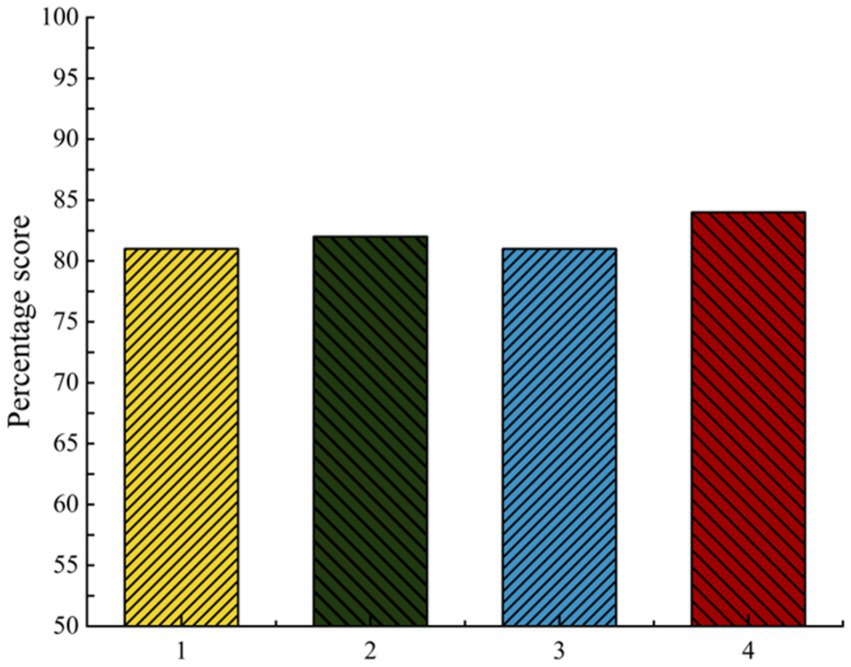
Figure 8. Teacher evaluations of inter-embedded teaching and learning situations. (1) Effectiveness of engineering talent cultivation. (2) Deep integration of innovative entrepreneurship education and professional education. (3) Diversity of teachers’ teaching methods. (4) Guiding role of discipline competitions in the teaching process.
3.3.3 Feedback from students
A questionnaire survey was conducted with 670 students at our school to analyze the effectiveness of inter-embedded teaching in four key areas. They included cultivating innovative thinking, developing innovation abilities, fostering the learning and accumulation of innovation-related knowledge, and enhancing students’ ability to solve complex problems. The items were scored on a four-point scale: 1 = excellent, 2 = good, 3 = moderate, and 4 = poor, corresponding to the horizontal coordinate in Figure 9. As can be seen from the figure, 92.5% of students rated at a good and moderate level in terms of cultivating innovative thinking. It is similar scores for the accumulation of innovation-related knowledge. This indicates that the students believe that inter-embedded teaching and learning have developed their innovative thinking and awareness. More than 60% of students gave favorable ratings of “good” or above for the cultivation of innovative ability. This also suggests that the students possess some level of innovative ability beyond basic knowledge of innovation. However, 47% of students rated their ability to solve complex problems as moderate, with most giving a medium rating. This suggests that students lack sufficient ability to solve complex problems. Therefore, complex tasks will be added to the 1.0-year enterprise practice training stage, which include cutting-edge technology research and development, interdisciplinary projects, horizontal projects of school-enterprise cooperation, etc. They allow students to participate in the design of full process solutions. This solution will encourage students to join enterprise production activities and teachers’ research projects.
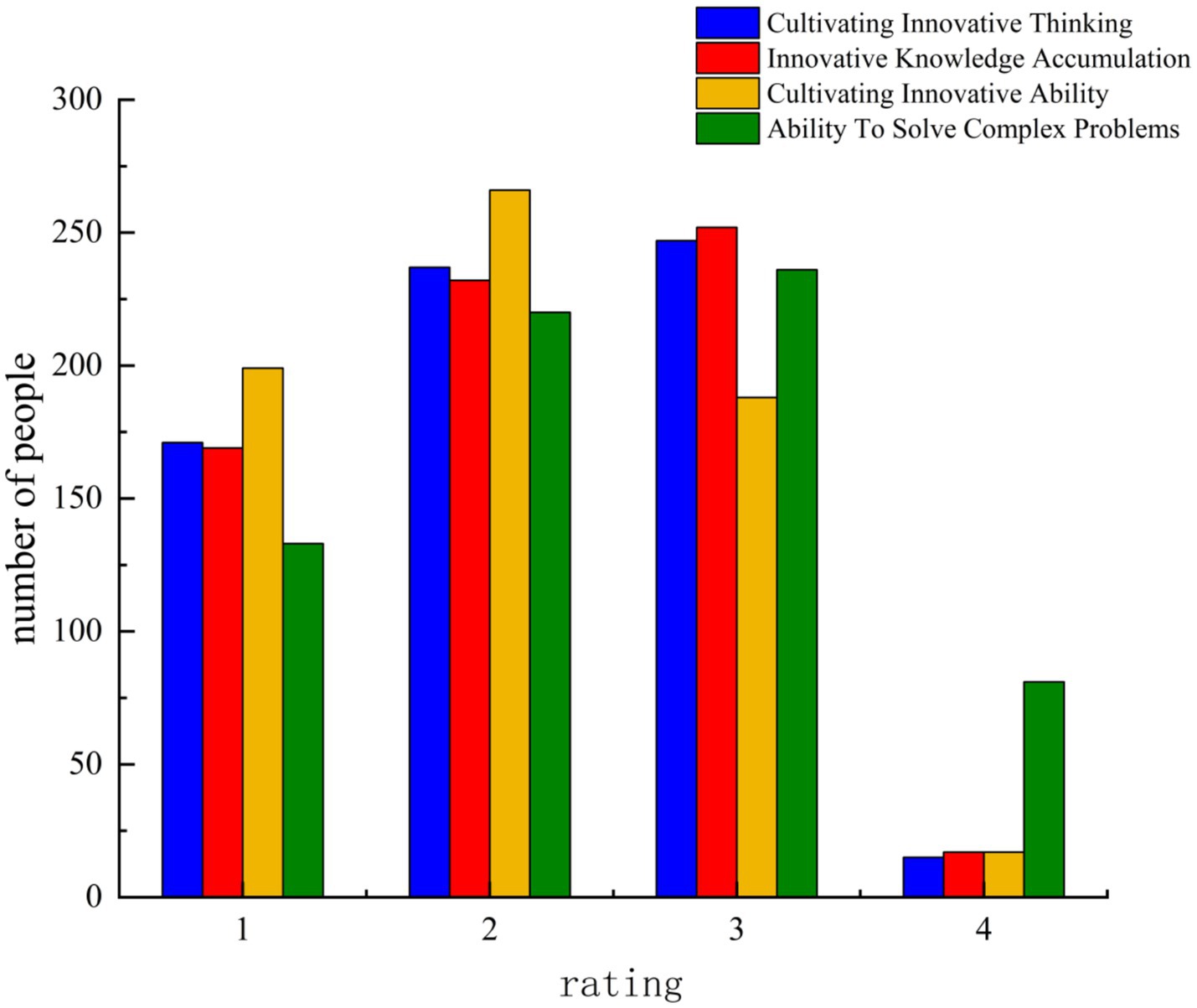
Figure 9. Student feedback regarding inter-embedded teaching and learning. (1) Excellent, (2) Good, (3) Moderate, (4) Poor.
3.4 Pluralistic integration and interdependence for continuous improvement
To improve the school’s mechanism for interconnected teaching, the Academic Affairs Office leads the overall planning and management coordination of talent cultivation. The School of Innovation and Entrepreneurship and the Career Guidance Center are responsible for constructing innovation and entrepreneurship practice bases, while the Science and Technology Office oversees the transformation of scientific and technological achievements. The university will continue to empower the cultivation of dual-creation talents with the advantages of synergy among government, industry, academia, and research and explore the mechanism of their integration for collaborative education. By organizing activities such as innovation and entrepreneurship education forums, exhibitions of innovation and entrepreneurship achievements, and selecting successful models of student innovation and entrepreneurship, the school aims to foster a culture of creativity and an environment that encourages bold innovation, embraces failure, and cultivates a social atmosphere that supports the innovation and entrepreneurship of college students. The departments mentioned above will continue to work together to coordinate intellectual property management, scientific research operations, and the transformation of research achievements, effectively promoting the incubation of innovation projects and the commercialization of scientific and technological achievements. It will also strengthen and enrich the engineering talent cultivation system.
4 Conclusion
This study offers four main conclusions:
A three-dimensional, six-stage inter-embedded education model for engineering and innovation entrepreneurship is presented here, built on the three dimensions of being Student-Centered, Outcome-Based Education, and Continuous Quality Improvement. It also encompasses the six phases of Cultivation Program Revision, Curriculum System Reform, Teaching Method Matching, Practice Teaching Optimization, Teaching Research Feedback, and Industry-Teaching Integration and Continuous Improvement. This creates an interconnected model in which each dimension and stage work together seamlessly.
In the inter-embedded innovative teaching team, academic titles are evenly distributed from junior to senior, with a higher proportion of teachers holding intermediate and associate senior titles. This group is primarily responsible for dual-creation and engineering education. According to the research and analysis, developed a team quality evaluation function for innovative teaching teams, which through empirical research and computational analysis yielded a score of 82.68 points (rated “Good”) for our university’s team.
Teachers were asked to evaluate the four phases of the inter-embedded teaching implementation program; all ratings exceeded 80 points. The highest evaluation was given to the disciplinary competitions in guiding the teaching process, strongly validating the feasibility and effectiveness of the inter-embedded teaching implementation program. However, there is still room for improvement in the diversity of teaching methods employed. Introducing blended learning and digital tools will be used in the continuous improvement process, such as combining virtual reality (VR) technology to simulate complex engineering scenarios, or utilizing online platforms to carry out cross school collaborative design projects, to compensate for the lack of traditional classrooms in reproducing real engineering.
Student feedback indicated high praise for the school’s fostering of innovative thinking, knowledge accumulation, and ability, indicating that the “three dimensions-six stages” teaching model has been effective. The students reported having developed strong innovative thinking and knowledge. Feedback also indicates that there are shortcomings in the ability to solve complex problems. In the future, it will be necessary to strengthen interdepartmental collaboration to improve the inter-embedded teaching system.
Data availability statement
The original contributions presented in the study are included in the article/supplementary material, further inquiries can be directed to the corresponding author.
Ethics statement
Ethical review and approval was not required for the study on human participants in accordance with the local legislation and institutional requirements. Written informed consent from the participants was not required to participate in this study in accordance with the national legislation and the institutional requirements.
Author contributions
CW: Project administration, Writing – original draft, Methodology. YX: Investigation, Writing – review & editing, Resources. ZX: Data curation, Writing – original draft. LL: Formal analysis, Data curation, Investigation, Writing – review & editing. XP: Investigation, Writing – review & editing, Visualization.
Funding
The author(s) declare that financial support was received for the research and/or publication of this article. This research was funded by Foundation of Henan Educational Committee, grant numbers 2024SJGLX0134 and JYS2025ZM06.
Conflict of interest
The authors declare that the research was conducted in the absence of any commercial or financial relationships that could be construed as a potential conflict of interest.
Generative AI statement
The authors declare that no Gen AI was used in the creation of this manuscript.
Any alternative text (alt text) provided alongside figures in this article has been generated by Frontiers with the support of artificial intelligence and reasonable efforts have been made to ensure accuracy, including review by the authors wherever possible. If you identify any issues, please contact us.
Publisher’s note
All claims expressed in this article are solely those of the authors and do not necessarily represent those of their affiliated organizations, or those of the publisher, the editors and the reviewers. Any product that may be evaluated in this article, or claim that may be made by its manufacturer, is not guaranteed or endorsed by the publisher.
References
Cao, W., Li, Y., and Guo, Y. (2024). Exploration of “double creation” talent training mode for automation specialty under engineering certification. Theory Pract. Innov. Entrep. 14, 141–144.
Chen, G., Xiao, Y., Yuan, Y., and Li, J. (2022). Research on path of mass entrepreneurship and innovation education reform in universities under background of new engineering. China Educ. Technol. Equip. 20, 106–109.
Hu, W. (2023). Experience and enlightenment of curriculum construction in foreign applied universities from the perspective of production-education integration——taking Germany, Britain, America and Australia as examples. Adult Educ. 5, 81–87.
Jiang, Z. (2024). Ruminations on several issues in accreditation of engineering education programs. China Univ. Teach. 6, 4–10.
Jiang, M. (2024). Research on case-based teaching reform of automatic control principle course based on discipline competition. J. High. Educ. 20, 157–160. doi: 10.19980/j.CN23-1593/G4.2024.20.038
Ministry of Education of the People's Republic of China. (2010). Notice of the Ministry of Education on the Approval of the First Batch of Colleges and Universities under the Excellence in Engineer Education Training Program [EB]. Available online at: http://www.moe.gov.cn/srcsite/A08/moe_742/s3860/201006/t20100630_109630.html (Accessed June 13, 2010).
Ministry of Education of the People's Republic of China. (2011). Circular of the Ministry of Education on the Approval of the Second Batch of Colleges and Universities under the Excellence in Engineer Education and Training Program [EB]. Available online at: http://www.moe.gov.cn/srcsite/A08/moe_742/s3860/201109/t20110929_125721.html (Accessed September 29, 2011).
Ministry of Education of the People's Republic of China. (2013). Circular of the General Office of the Ministry of Education on the Announcement of the List of Disciplines and Majors in the Third Batch of Excellence in Engineer Education and Cultivation Plan [EB]. Available online at: http://www.moe.gov.cn/srcsite/A08/moe_742/s3860/201310/t20131021_158875.html (Accessed October 10, 2013).
Tang, J., Qi, W., and Xuemeng, X. (2019). Analysis and implications of the current situation of curriculum teaching reform in the context of new engineering sciences. J. High. Educ. 13, 112–114. doi: 10.19980/j.cn23-1593/g4.2019.13.038
Tong, Y., Chen, J., and Jiang, Y. (2021). Construction of innovation and entrepreneurship education system based on cross innovation practice education platform. Res. Expl. Lab. 11, 193–198. doi: 10.19927/j.cnki.syyt.2021.11.041
Wang, L., Lifang, H., Cheng, W., and Wang, X. (2022). Construction strategy and implementation path of innovative excellent talent training mode under the new engineering vision. Theory Pract. Innov. Entrep. 5, 151–153.
Wang, Q., Liu, X., Zeng, J., and Zeng, Q. (2024). Exploration of the “double creation and double integration” talent cultivation system in urban underground space engineering major under the background of education evaluation reform in the new era. Theory Pract. Innov. Entrep. 7, 146–149.
Yang, Q., Li, P., and Luo, H. (2021). Research on the reconstruction path of curriculum system of internet of things application technology professional group under the background of “double-high plan”. Voc. Educ. Mech. Ind. 4, 32–36. doi: 10.16309/j.cnki.issn.1007-1776.2021.04.008
Zhao, L. (2022). Research and suggestions on the evolution of full-time teachers in regular senior secondary schools in China (2001–2020). Master's thesis: Zhengzhou University. doi: 10.27466/d.cnki.gzzdu.2022.005085
Keywords: engineering education, dual-creation education, inter-embedded, engineering talents, cultivation mechanisms
Citation: Wang C, Xiao Y, Xiao Z, Li L and Pan X (2025) Exploration and practice of an inter-embedded engineering excellence talent cultivation mechanism with three dimensions and six stages. Front. Educ. 10:1632525. doi: 10.3389/feduc.2025.1632525
Edited by:
Wang-Kin Chiu, The Hong Kong Polytechnic University, ChinaReviewed by:
Hideyuki Kanematsu, Osaka University, JapanRirin Ambarini, Universitas PGRI Semarang, Indonesia
Copyright © 2025 Wang, Xiao, Xiao, Li and Pan. This is an open-access article distributed under the terms of the Creative Commons Attribution License (CC BY). The use, distribution or reproduction in other forums is permitted, provided the original author(s) and the copyright owner(s) are credited and that the original publication in this journal is cited, in accordance with accepted academic practice. No use, distribution or reproduction is permitted which does not comply with these terms.
*Correspondence: Zhiling Xiao, eHpsMDMyMjNAMTI2LmNvbQ==
 Caidong Wang
Caidong Wang Yanqiu Xiao1
Yanqiu Xiao1 Zhiling Xiao
Zhiling Xiao